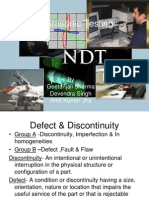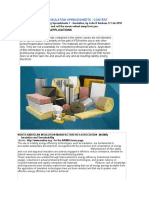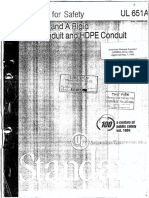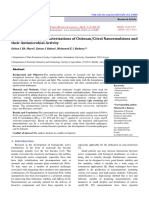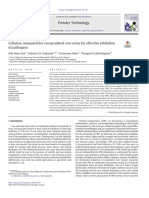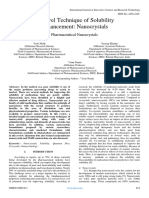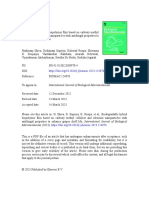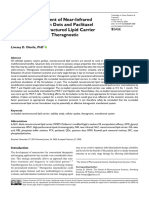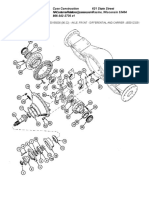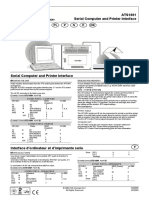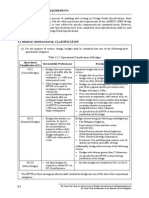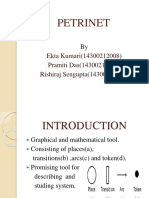Professional Documents
Culture Documents
Nanosilica For Sustained Release of Quercetin and Its Antioxidant Activity
Uploaded by
Anonymous izrFWiQOriginal Title
Copyright
Available Formats
Share this document
Did you find this document useful?
Is this content inappropriate?
Report this DocumentCopyright:
Available Formats
Nanosilica For Sustained Release of Quercetin and Its Antioxidant Activity
Uploaded by
Anonymous izrFWiQCopyright:
Available Formats
Volume 4, Issue 5, May – 2019 International Journal of Innovative Science and Research Technology
ISSN No:-2456-2165
Nanosilica for Sustained Release of Quercetin and its
Antioxidant Activity
Manoj K. Patil1*, Siddhita S. Padhye2, Rhea M. Nair3
Haffkine Institute for Training, Research and Testing
Parel, Mumbai India.
Abstract:- This study was carried out to synthesize output is estimated is 80 million tons. So it is an eco-
silica nanoparticles for Sustained drug release. friendly process as it minimizes the paddy husk ash waste.
Synthesis of nanosilica was carried out from Rice husk Rice husk are often left to rot in field or burnt in open. Rice
ash by sol-gel method and the size distribution was husk contains silica in range of 20- 25wt%. The silica in
controlled by using different surfactants like, a cationic rice husk exists in the hydrated amorphous form like silica
(CTAB) and anionic (SDS) surfactant. The quercetin – gel. The amorphous nature of silica in rice husk makes it
a flavonoid was successfully incorporated in nanosilica extractable. Thermal degradation and pyrolysis of rice husk
synthesized using 2% SDS surfactant and was grafted followed by the combustion of the char results in a highly
with PEG 4000. The quercetin loading capacity into porous and amorphous silica with a varying percentage of
nanosilica was determined depending on different unburnt carbon. Combusted at moderate temperature, the
concentrations used for loading. The release of this white ash obtained from rice husk contains approximately
loaded quercetin was traced using UV 92-97% amorphous silica [2].
spectrophotometer for sustained release in Ethyl
acetate. The % release profile was also determined. The Highly pure, small particle-size nano silica powder
Antioxidant activity of the quercetin incorporated with high-surface area from agricultural by-product, such
nanosilica was checked using a DPPH antioxidant as rice husk ash, by using a simple user-friendly, alkali
assay. The successful nanosilica synthesis and drug extraction followed by an acid precipitation method. The
loading and grafting by PEG 4000, all were confirmed method is simple, cost-effective, reliable and reproducible.
by using characterization techniques like Dynamic light The purity obtained by this method is enhanced to
scattering for particle size analysis, Scanning electron conventional methods [3].
microscopy (SEM) and IR spectroscopy.
B. Drug Loading and PEG Grafting:
Keywords:- Silica nanoparticles, Rice husk ash, sol-gel Flavonoids are a large group of phenolic compounds
method, Surfactants, CTAB, SDS, Quercetin, PEG 4000, that are widely spread in different plant foods. Quercetin
Sustained release, Antioxidant activity, 2,2-diphenyl-1- (3,3′,4′,5,7-pentahydroxyflavone) is a common dietary
picrylhydrazyl(DPPH), UV spectrophotometer, Particle flavonol with a wide range of pharmacological activities
size analysis, SEM and IR spectroscopy. including antioxidant, antiplatelet, anti-inflammatory,
antimutagenic, anticarcinogenic, antiangiogenic,
I. INTRODUCTION antibacterial, antitumor, antiviral, and hepatoprotective.
The beneficial biological properties of quercetin make it a
A. Synthesis of Nanosilica: promising therapeutic agent. A possible approach to
Manipulation of matter on a 'nano' scale, is overcome this problem is loading of quercetin in
considered to be a key enabling technology. It is commonly appropriate drug delivery systems [4]. The possibility of a
known as nanomedicine, Medical applications of combination of controlled drug delivery and biocompatible
nanomaterials are expected to significantly improve disease properties of mesoporous silica has great advantages once
diagnostic, therapeutic modalities and subsequently reduce silica can induce bioactivity through its extrinsic properties.
health care costs [1]. Silica has a porous network with different diameters and
extensions that provide the possibility of hosting different
The nano silica powder is generally prepared by using molecules. The wall structures of silica pores are formed by
sol–gel method. In most of these methods, nano silica a disordered network of free silanol groups and silane
powder is synthesized using chemicals as a raw material. In bonds that act as reactive nuclei and can be hosts for
chemical methods, it is easy to control size, shape and chemical species [5-8].
purity of the material but the starting reagents are costly. In
industrial applications, low costs and large quantities of This paper to contribute to the development of drug
initial precursor are needed. Rice husk ash is one of the controlled release systems for the treatment of diseases like
most abundant by-products produced in the paddy field. cancer. Thus, mesoporous silica matrix were synthesized
Rice husk is a form of waste from the rice milling and characterized the flavonoid quercetin (C15H10O7) was
industries and is produced in abundance in around the incorporated to the particles.
country. All riceproducing countries have abundant
quantity of rice husk. India alone produces 12 million tons
of rice husks every year. Thus worldwide annual husk
IJISRT19MY465 www.ijisrt.com 270
Volume 4, Issue 5, May – 2019 International Journal of Innovative Science and Research Technology
ISSN No:-2456-2165
In this field drug delivery system utilizing polymeric constant temperature, after which drug release is assessed
carrier, which covalently conjugates molecule of interest, by sampling of the release media (filtrate or supernatant) or
plays an important role in modern therapeutics. Such the nanoparticles [13]. The use of syringe filters to achieve
polymer-based drug entities are called as “polymer physical separation between the release media and
therapeutics” The objectives for designing polymer nanoparticles, the small size of nanoparticles has separated
therapeutics are primarily to improve the potential of the by use of high energy separation techniques like
respective drug by enhancing water solubility, particularly centrifugation, ultracentrifugation, and ultrafiltration.
relevant for drugs with low aqueous solubility, targeted Generally, this method provides a direct approach to
delivery of drugs to specific site of action in the body and monitor drug release [14]. In continuous flow drug release
Stability against degrading enzymes or reduced uptake by occurs as a result of buffer or media constantly circulating
endothelial system. The smart drug delivery systems should through a column containing the immobilized dosage form
possess some important feature such as pre-scheduled rate, and is monitored by collecting the eluent at periodic
self-controlled, targeted, predetermined time and monitor intervals. Most used method is sample and separate, only a
the delivery [9]. PEG pro-drugs have been designed mostly few examples of the continuous flow have been reported
for the delivery of anticancer agents due to its overall for nano-sized dosage forms. Flow rates used in this
implications in the treatment. However it should be noted method depend on the type of pump as well as the filters
that PEG-antitumor pro-drug is expected to be stable used. This method suffer from several disadvantages
during circulation and degrade or hydrolyze only on including difficulty in set-up, instrument costs, filter
reaching the targeted site [10]. The coating or clogging, adsorption to the filter and glass beads, and
encapsulation of nanoparticles has been found to be of difficult to maintain the constant flow rate lead to variables
particular interest in sustained drug delivery. A in results. Low flow rates have been known to be a key
polyethylene Glycol as a coating steric stabilizer is factor causing slow or incomplete release from dosage
covalently bound to the particle at the one end Thus, in an forms [15]. This is the most versatile and popular method,
aqueous suspension, the aggregation among the in this method, physical separation of the dosage forms is
nanoparticles is prevented by the repulsion force of the achieved by usage of a dialysis membrane which allows for
PEG surface moiety. Some of the advantages are PEG is ease of sampling at periodic intervals. In general, the
nontoxic, and its attachment to silica nanoparticles provides volume enclosed in a dialysis bag (inner media) is
a biocompatible and protective surface. Due to high significantly smaller than the outer media. Thus, container
aqueous solubility, PEG polymer is considered as a size will depend on the total volume of release media
versatile candidate for drug conjugation [11]. required for the in vitro release study. In the regular
dialysis technique, drug released from the nanoparticles
C. Sustained Release: diffuses through the dialysis membrane to the outer
Much attention has been devoted to the development compartment from where the samples analysed [16].
of suitable apparatus to assess in vitro release from
nanoparticulates. In contrast to oral dosage forms where D. Determination of Antioxidant activity from nanosilica
release media typically mimics pH of the gastrointestinal To determine the antioxidant activity in a like manner
tract, selection of release media for nano-sized dosage by using a stable free radical α, α-diphenyl-β-
forms will vary depending on the site of administration as picrylhydrazyl (DPPH; C18H12N5O6, M = 394.33). The
well as the site of action of the formulation. In general, assay is based on the measurement of the scavenging
selection of release media for nanoparticulate preparation is capacity of antioxidants towards it. The odd electron of
generally based on drug solubility and stability, assay nitrogen atom in DPPH is reduced by receiving a hydrogen
sensitivity, and the method used. Drug releases from atom from antioxidants to the corresponding hydrazine.
nanoparticle by three categories, such as sample and DPPH can accept an electron or hydrogen radical to
separate (SS), continuous flow (CF), and dialysis become a stable, diamagnetic molecule; it can be oxidized
membrane (DM) methods [12]. only with difficulty, and then irreversibly. DPPH shows a
strong absorption band at 517 nm due to its odd electron
and solution appears a deep violet colour, the absorption
vanishes as the electron pairs off. The resulting
decolourization is stoichiometric with respect to the
number of electrons taken up.
It is a rapid, simple, inexpensive and widely used
method to measure the ability of compounds to act as free
radical scavengers or hydrogen donors, and to evaluate
antioxidant activity of foods. It can also be used to quantify
antioxidants in complex biological systems, for solid or
Fig 1:- Schematic for sustained drug release from liquid samples. DPPH method may be utilized in aqueous
nanosilica and non-polar organic solvents and can be used to examine
both hydrophilic and lipophilic antioxidants. Ascorbic acid
In the sample and separate method, the dosage form is is used here as a standard antioxidant.
introduced into the release media that is maintained at a
IJISRT19MY465 www.ijisrt.com 271
Volume 4, Issue 5, May – 2019 International Journal of Innovative Science and Research Technology
ISSN No:-2456-2165
II. EXPERIMENTAL SECTION of this mixture (at 375 nm) was then taken using an UV
spectrophotometer and noted down, 100 mg of silica
A. Materials: nanoparticles synthesized using 2% SDS surfactant was
Rice Husk Ash (obtained from Ahmedabad, India), weighed and added into the vial. The assembly was stirred
Sodium hydroxide (Merck grade), Surfactants CTAB for around 27 hours using a magnetic stirrer.
(Cetyltrimethylammonium Bromide and SDS (Sodium
dodecyl sulfate) (S.D.Fine Chem), Sulphuric Acid (Merck
grade), Quercetin (Sigma Aldrich), Polyethylene Glycol PEG grafting of Quercetin loaded Silica nanoparticles:
molecular weight 4000 (PEG 4000), Whatman Filter paper, The absorbance of stirred sample was taken (at 375
L-Ascorbic acid stock, Ethyl Acetate (Merck Grade), and nm) using UV spectrophotometer, samples showed increase
DPPH (2,2-diphenyl-1-picrylhydrazyl). (Sigma Aldrich). in absorbance reading compared to the absorbance taken
for quercetin stock before loading. 100 mg of Polyethylene
B. Methods: Glycol molecular weight 4000 (PEG 4000) was weighed
and added to reaction mixture in and the assembly was then
Extraction of Silica from Rice Husk Ash (RHA): kept on stirring for 24 hours using a magnetic stirrer. After
2.5 N NaOH solution was added in to 25 gm of RHA, stirring, the mixture was filtered out using a Whatman
mixed using a clean glass road and the beaker was kept for Filter paper. The absorbance of filtrate (at 375 nm) was
boiling for 90 minutes continuous stirring was carried out taken using an UV spectrophotometer and noted down. The
during boiling. After 90 minutes, content was allowed to PEG coated Quercetin loaded nano-silica which was
cool down and the solution was filtered using a whatman retained on filter paper was allowed to air dry and then
filter paper, obtained filtrate was sodium silicate and stored properly in sample vial and kept in dark.
residue above the filter paper is carbon. The residual carbon
was washed using distilled water and then dried in a hot air Sustained release of Quercetin from PEG coated
oven. Quercetin loaded nanosilica:
5 mg of PEG coated quercetin loaded nano-silica was
2NaOH (aq.) + RHA (s) Na2SiO3 (aq.) weighed and added to 10 ml Ethyl acetate in a glass vial.
+H2O (g) Immediately after the addition, 2 ml aliquot was taken and
absorbance was checked at 375 nm (0 minute reading). The
Sodium Hydroxide Sodium silicate same aliquot was added back to vial and then assembly was
kept undisturbed throughout experimentation time,
Preparation of mesoporus Nanosilica: absorbance readings (at 375 nm) were taken using an UV
Sodium silicate solution was split up into two beaker spectrophotometer after some definite time intervals in a
and adds 2% Cetyl trimethylammonium Bromide (CTAB) fashion similar to 0 minute reading. The process was
cationic surfactant in one beaker and 2% Sodium dodecyl repeated till a constant absorbance reading was obtained.
sulfate (SDS) anionic surfactant was added into another This reading indicates the maximum release of the
beaker. 5 M H2SO4 was added drop wise using separating quercetin from nanosilica.
funnel till neutral pH was achieved, after achieving neutral
pH the mixture was stirred for extra half hour. The mixture Determination of Antioxidant activity using DPPH:
was centrifuged at 500 rpm for 6 minutes, the supernatant 10 μg/ml L-Ascorbic acid stock was prepared in
obtained was discard and warm distilled water was added, distilled water and kept for sonication for 15 minutes prior
this step repeated till all the un reacted surfactant was to use and 2 μM DPPH stock was prepared in Ethanol. The
removed. Residue was dried in hot air oven at 90 °C around stock was prepared and stored in amber coloured bottle and
8 hrs. Dried residue was grounded as fine as possible using at cold temperature (4 °C). Based on controlled release
mortar and pestle. calculations, stock of 1 μg/ml quercetin in Ethyl acetate
was prepared, dilutions of this stock served as positive
Surfactant control for released quercetin, 400 μl aliquot of released
Na2SiO3 (aq.) + H2SO4 (aq.) SiO2(s) + Na2SO4 (aq.) + H2O quercetin was taken from PEG coated quercetin loaded
Sodium silicate Sulphuric acid Silica oxide NP nano-silica sample added in Ethyl acetate after constant
absorbance reading at 375 nm taken using an UV
Incorporation of quercetin in Silica Nanoparticles: spectrophotometer.
Quercetin was incorporated into silica nanoparticles
synthesized using 2% SDS surfactant. Quercetin stock of The dilutions of L-Ascorbic acid stock were made as
10μg/ml was prepared in ethanol. The stock was properly per the table 1.
stirred by using Sonicator for 15 minutes. The absorbance
IJISRT19MY465 www.ijisrt.com 272
Volume 4, Issue 5, May – 2019 International Journal of Innovative Science and Research Technology
ISSN No:-2456-2165
Concentration of Ascorbic acid Volume of Ascorbic acid Diluent/ distilled water Total volume
(μg/ml) stock (μl) (μl) (μl)
0 -- 400 400
0.3 12 388 400
0.3 13 384 400
0.6 24 376 400
0.8 32 368 400
1.0 40 360 400
Table 1:- DPPH Assay dilutions for 10 μg/ml L-Ascorbic acid
Sample Concentration Volume of sample stock Diluent/ Ethyl acetate Total volume (μl)
(μg/ml) (μl) (μl)
0.2 Quercetin 80 320 400
0.4 Quercetin 160 240 400
0.6 Quercetin 240 160 400
0.8 Quercetin 320 80 400
Released Quersetin. 400 -- 400
Table 2:- DPPH Assay dilutions for PEG coated Quercetin loaded nanosilica and Positive controls.
All the dilutions were made 3600 μl of DPPH was role in obtaining the pure quality of silica. The silica
added to each tube, all the tubes were kept on sonicator for obtained is in form of sodium silicate (solution), after
half a minute. This was done to mix all the contents well. addition of surfactants (2 % CTAB and 2% SDS) and
The tubes were incubated in dark at room temperature for treatment with sulphuric acid the sodium silicate gets
30 minutes. The absorbance was taken at 515 nm using an converted to gel. Thus, the process is sol-gel. The obtained
UV Spectrophotometer. Based on the results, % gel is filtered and dried, SiO2 in powder form.
Scavenging activity of released quercetin was calculated
with following formula. RHA (gm) Silica synthesized % Silica
(gm) yield
25 20.4 81.60%
Table 3:- The % yield of synthesized silica
B. Characterization of Nanosilica:
III. RESULTS AND DISCUSSION
Particle Size Analysis:
A. Nanosilica Extracted from RHA: Particle size analysis was carried out, for nanosilica
The concentration of sodium hydroxide (2.5 N) used made using 2% CTAB and 2% SDS surfactant.
for extraction of silica from Rice husk ash plays significant
Fig 2:- Particle size distribution for silica made using 2% CTAB.
IJISRT19MY465 www.ijisrt.com 273
Volume 4, Issue 5, May – 2019 International Journal of Innovative Science and Research Technology
ISSN No:-2456-2165
Fig 3:- Particle size distribution for nanosilica made using 2% SDS.
The distribution obtained in silica made using 2% result. The particle sizes obtained during 3 iterations were
CTAB is not an ideal one. The particle sizes (diameters) 142.4 nm, 140.2 nm and 159.9 with average particle
obtained in three iterations was 5638.5 nm, 4915.7 nm and diameter of 147.5 nm. It was also found that in the
13213.4 nm. These are in micrometer ranges and thus, the dispersion 10% of scanned particles were having diameter
silica powder synthesized cannot be considered as less than 68.8 nm while 90% of scanned particles were
nanosilica. This could have been happened due to having diameter less than 172.3 nm. Thus, the width of the
agglomeration. The huge variations during 3 iterations also graph tells us that the particle falls in range of around 70 –
shows that small sized particles might be present in 170 nm. Thus, nanosilica with quite low polydispersibility
solution, but presence of large particles are hiding them index (0.109) was obtained using 2% SDS surfactant. Same
from DLS laser source. This silica sample was not used for sample was used for further experimentation.
any further experimentation.
The SEM was carried out only on nanosilica made
The particle size distribution obtained for nanosilica using 2% SDS surfactant.
sample made using 2% SDS surfactant showed an ideal
Fig 4:- The SEM result for nanosilica made using 2% SDS from 5 μm
IJISRT19MY465 www.ijisrt.com 274
Volume 4, Issue 5, May – 2019 International Journal of Innovative Science and Research Technology
ISSN No:-2456-2165
Fig 5:- The SEM result for nanosilica made using 2% SDS from 10 μm.
The data was collected over a selected area of 5 µm
and 10 µm surface of the sample. The difference between
two images is clear, as smaller distance (5 µm) shows less
particles but high focus, while larger distance (10 μm)
shows more particles. The results indicate that,
agglomeration of nanosilica is present. This was very well
expected as no functionalization of nanosilica or polymer
coating was carried out at this stage. The nanoparticles
obtained are irregularly shaped and thus have many cavities
over its surface. Such topography is suitable for loading a
drug moiety in it by simple physical attachment or
adsorption [17]. Thus, the nanosilica can be used for
loading of quercetin.
Fig 7:- IR results for nanosilica made using % SDS.
The CH2 bending at 1631.06 cm-1 and Si-O-Si
stretching at 1089.07 cm-1, confirms the silica particles
controlled by SDS surfactant. The shift seen in CH3
asymmetric stretching and CH2 bending (includes
scissoring and wagging) band pattern reconfirms the same.
Fig 6:- IR results for silica made using 2% CTAB.
Infra Red (IR) gives idea about the molecules
(functional groups) present in the given sample.
Broad peak at 3200 cm-1 indicates presence of OH
groups. The CH2 stretching at 2852.01 cm-1 and Si-O-Si
stretching at 1096.78 cm-1, confirms the silica particles
controlled by CTAB surfactant.
Fig 8:- IR results for nanosilica made using 2% SDS and
PEG coating.
IJISRT19MY465 www.ijisrt.com 275
Volume 4, Issue 5, May – 2019 International Journal of Innovative Science and Research Technology
ISSN No:-2456-2165
The intensity of peak at 1641.42 cm -1 which SDS surfactant reconfirm the same, as addition of quercetin
corresponds to peak at 1631.06 cm-1 in figure 4.2.5 is much has changed their interaction environment.
smaller. This indicates the successful grafting by Poly
ethylene glycol (PEG), as it hides the exposed groups of IV. LOADING AND RELEASE PROFILE
silica and SDS surfactant.
A. Standard graph for Quercetin loading:
In order to obtain concentration of quercetin that has
been loaded in nanosilica, it is important to first plot a
standard graph for a range of quercetin concentrations. The
slope of this graph will be used to determine the
concentration based on the absorbance obtained by UV-
spectrophotometer. For 0.01% quercetin loading, a stock of
10µg/ml in ethanol was directly used, while for 10%
loading, a stock of 10 mg/ml was used. But 10 mg/ml is
very high range of concentration for spectrophotometric
analysis and hence, was diluted 1000 times.
Fig 9:- IR results for Standard Quercetin.
Broad peak at 3200 cm-1 indicates presence of OH
groups which are largely present in quercetin structure
itself. The C=O stretching at 1666.50 cm-1 is a strong
indicator of quercetin. The expected frequencies with
respect to quercetin in presence of silica have been
considered from the literature [18].
Fig 11:- Standard graph for loading 2-10 μg/ml Quercetin
in Ethanol.
B. Standard graph for Quercetin release:
In order to obtain concentration of quercetin that has
been released from nanosilica, it is important to first plot a
standard graph for a range of quercetin concentrations. The
slope of this graph will be used to determine the
concentration based on the absorbance obtained by UV-
spectrophotometer. For 0.01% quercetin loading, a stock of
10µg/ml in ethyl acetate was used.
Fig 10:- The IR results for PEG coated 0.01% Quercetin
loaded nanosilica made using 2% SDS.
Broad peak at 3200 cm-1 indicates presence of OH
groups of quercetin. The slight shift of C-H stretching
bands of quercetin at 1648.20 cm-1 and 1640.72 cm-1 in
respective loaded nanosilica are indication of successful
loading. Also, the slight shifts in Si-O-Si stretching at Fig 12:- Standard graph for release 2-10 μg/ml Quercetin in
1092.93 cm-1 of silica and CH2 wagging at 1347.54 cm-1 of Ethyl acetate.
IJISRT19MY465 www.ijisrt.com 276
Volume 4, Issue 5, May – 2019 International Journal of Innovative Science and Research Technology
ISSN No:-2456-2165
C. Sustained release of Quercetin from nanosilica: taken and it thus contains 0.4115µg of Quercetin. This is
the highest amount of quercetin that can be released. The %
Sr. Time Absorbanc Sr. Time Absorbanc loading was found to be 82.30%.
No (mins e (at 375 No (mins e (at 375
. ) nm) . ) nm) 5 mg of sample was suspended in 10 ml of Ethyl
1. 0 0.0227 9. 90 0.1259 acetate. The absorbance obtained after 120 minutes was
2. 10 0.0447 10. 100 0.1402 0.0459. Based on slope value obtained from graph 12, the
3. 20 0.0559 11. 110 0.1460 released quercetin was 0.389 µg for 5 mg nanosilica. The
4. 30 0.0832 12. 120 0.1526 highest amount of quercetin that can be released is 0.4115
5. 50 0.1028 13. 150 0.1400 µg. Thus, % release was found to be 94.53%.
6. 60 0.1063 14. 180 0.1467
7. 70 0.1114 15. 210 0.1344 E. Scavenging Property of Quercetin incorporated
8. 80 0.1111 nanosilica:
Table 3:- Absorbance of released quercetin from 0.01%
Quercetin loaded nanosilica in Ethyl acetate Standard graph for DPPH activity:
In order to obtain % scavenging activity quercetin
that has been released from nanosilica, it is important to
first plot a standard graph for a range of L-ascorbic acid
concentrations for DPPH scavenging. The slope of this
graph will be used to determine the concentration based on
the absorbance obtained by UV- spectrophotometer. For
0.01% quercetin nanosilica, a stock of 10 µg/ml L-Ascorbic
acid in distilled water was used. L-Ascorbic acid is a
standard antioxidant used for DPPH assay, and the
respective samples.
Concentration of L- Absorbance (at 515 nm)
Ascorbic acid (µg/ml)
0 0.0153
0.3 0.0111
0.4 0.0083
0.6 0.0065
0.8 0.0042
Fig 13:- Graph of sustained release from PEG coated 1.0 0.0016
0.01% Quercetin loaded nanosilica. Table 5:- DPPH assay of 0.3-1.0 μg/ml L-ascorbic acid
stock.
5 mg of PEG coated 0.01% Quercetin loaded
nanosilica particles were tested for release profile in 10 ml
of Ethyl acetate. It can be seen that sustained release of
quercetin is seen till 120 minutes as the absorbance
readings at this point are maximum and stable.
D. Amount Quercetin loaded and released:
10 ml of 10 µg/ml Quercetin stock prepared in
ethanol was taken and 100 mg nanosilica was used for drug
incorporation. For obtaining the absorbance of the same the
values were extrapolated on graph obtained in figure 13.
Sr. Sample Absorbance (at 375
No. nm)
1. Before loading 1.4363
2. Residual filtrate post 0.2532
PEG coating
Table 4:- Absorbance of quercetin for 0.01% loading
nanosilica in Ethanol Fig 14:- Standard graph of 0.3 -1 µg/ml L-ascorbic acid
antioxidant assay using DPPH.
Based on slope value obtained from graph 11, the
unloaded quercetin was 1.77µg and hence loaded amount The equation of the graph was found to be y=-0.013x
of quercetin was found to be 8.23 µg for 100 mg nanosilica. + 0.014. The y in line equation indicates absorbance
The release study, 5 mg loaded nanosilica sample was reading while x represents corresponding concentration.
IJISRT19MY465 www.ijisrt.com 277
Volume 4, Issue 5, May – 2019 International Journal of Innovative Science and Research Technology
ISSN No:-2456-2165
[3]. R. Yuvakkumar, V. Elango, V. Rajendran and N.
Sample concentration (µg/ml) Absorbance (at 515 Kannan, “High-purity nano silica powder from rice
nm) husk using a simple chemical method”, Journal of
0.2 Quercetin 0.0122 Experimental Nanoscience, Volume 9, Issue 3,
0.4 Quercetin 0.0076 (2014).
0.6 Quercetin 0.0058 [4]. PHARMACIA, vol. 63, No. 4/2016 D. Aluani, V.
0.8 Quercetin 0.0031 Tzankova, Y. Yordanov, A. Zhelyazkova, E.
Released Q. 0.01% 0.0097 Georgieva, K. Yoncheva Quercetin: an overview of
biological effects and recent development of drug
Table 6:- DPPH Assay for PEG coated Quercetin loaded delivery systems.
nanosilica and Positive controls [5]. ESPUELAS, S. Delivery systems for the treatment
and prevention of leishmaniosis. Gazeta Médica da
Based on equation obtained from graph 4.5.1, the Bahia, v.79, p. 134-146, 2009.
released quercetin from 0.01% nanosilica was found to be [6]. BELYAKOVA, L.A.; VARVARIN, A.M. Surfaces
0.37 µg after 120 minutes; the expected amount was 0.31 properties of silica gels modified with hydrophobic
µg and % scavenging property was found to be 36.60%. groups. Colloids and Surfaces A: Physicochem. Eng.
IC50 value for the assay was found to be 0.53µg/ml AAE. Aspects, v.154 p. 285–294, 1999.
[7]. HORCAJADA, P.; RÁMILA, A.; PÉREZ-
V. CONCLUSION PARIENTE, J.; VALLET-REGI, M. Influence of
pore size of MCM-41 matrices on drug delivery rate.
In summary, we have developed a simple approach to Microporous and Mesoporous Materials, v.68 n.1-3,
prepare an intelligent drug controlled delivery system. p. 105-109, 2004.
Nanosilica particles with irregular shape and amorphous [8]. SLOWING, I.I.; VIVERO-ESCOTO, J. L.; Wu, C.
nature were synthesized from Rice husk ash. The synthesis W.; LIN, V. S.-Y. Mesoporous silica nanoparticles as
was based on sol-gel method cationic surfactant (CTAB) controlled release drug delivery and gene transfection
and SDS anionic surfactant was used in order to guide the carriers. Advanced Drug Delivery, v.60, p. 1278–
nanoparticle production. It was found that, the use of 1288, 2008.
CTAB surfactant gave more yield by weight but the size of [9]. T. Andreani, A. L. de Souza, C. P. Kiill, E. N.
these particles was in micrometer range. Whereas, SDS Lorenzón, J. F. Fangueiro, A. C. Calpena, M. V.
yield was comparatively less than CTAB, but was in Chaud, M. L. Garcia, M. P. Gremião, A. M. Silva and
nanometer range (70-170 nm). This suggests a possibility E. B. Souto, “Preparation and characterization of
that CTAB surfactant has less control in silica particle size PEG-coated silica nanoparticles for oral insulin
than SDS surfactant. Scanning electron microscope (SEM) delivery”, Int J Pharm. Oct 1;473(1-2):627-35,
analysis on nanosilica made using SDS surfactant showed (2014).
irregularity of surface, this indicates that the adsorption of [10]. D. Bennet and S. Kim, “Polymer Nanoparticles for
quercetin on such surface is possible, thus making it a Smart Drug Delivery”, INTECH, (2014).
suitable candidate for quercetin as drug loading. The [11]. H. Xu, F. Yan, E. Monson and R. Kopelman, “Room
quercetin is known to have antioxidant properties and temperature preparation and characterization of poly
hence, both nanosilica samples (after 120 minutes release) ethylene glycol coated silica nanoparticles for
were used in antioxidant assay using DPPH. Batch-1 biomedical applications”, Wiley Periodicals, (2013).
particles showed 63.39% scavenging activity while Batch-2
showed 36.60%. The IC50 value for the given assay [12]. Susan D’Souza, “A Review of in Vitro Drug Release
concentration was found to be 0.53 µg/ml AAE. Test Methods for Nano-Sized Dosage Forms,”
Advances in Pharmaceutics, Article ID 304757, 12
ACKNOWLEDGMENT pages, (2014).
[13]. V. Sanna, A. M. Roggio, S. Siliani et al.,
The authors gratefully acknowledge the support of the “Development of novel cationic chitosan-and anionic
Director, Haffkine Institute for Training, Research and alginate-coated poly(D,L-lactide-co-glycolide)
Testing Parel Mumbai. nanoparticles for controlled release and light
protection of resveratrol,” International Journal of
REFERENCES Nanomedicine, vol. 7, pp. 5501–5516, (2012).
[14]. Y. I. Kim, L. Fluckiger, M. Hoffman, I. Lartaud-
[1]. P. Satalkar, B. S. Elger and D. M. Shaw, “Defining Idjouadiene, J. Atkinson and P. Maincent, “The
Nano, Nanotechnology and Nanomedicine: Why antihypertensive effect of orally administered
Should It Matter?” Sci Eng Ethics. Oct; 22(5):1255- nifedipine-loaded nanoparticles in spontaneously
1276, (2016). hypertensive rats,” The British Journal of
[2]. Heta Gandhi1, A.N. Tamaskar2, Harshali Parab3 and Pharmacology, vol. 120, no. 3, pp. 399–404, (1997).
Sonam Purohit4 Journal of Basic and Applied [15]. S. S. D'Souza and P. P. DeLuca, “Methods to assess
Engineering Research Print ISSN: 2350-0077; Online in vitro drug release from injectable polymeric
ISSN: 2350-0255; Volume 2, Number 4; January- particulate systems,” Pharmaceutical Research, vol.
March, 2015, pp. 330-333. 23, no. 3, pp. 460–474, (2006).
IJISRT19MY465 www.ijisrt.com 278
Volume 4, Issue 5, May – 2019 International Journal of Innovative Science and Research Technology
ISSN No:-2456-2165
[16]. X. Xu, M. A. Khan, and D. J. Burgess, “A two-stage
reverse dialysis in vitro dissolution testing method for
passive targeted liposomes,” International Journal of
Pharmaceutics, vol. 426, no. 1-2, pp. 211–218,
(2012).
[17]. S. M. Haidary, E. P. Córcoles, and N. K. Ali,
“Nanoporous Silicon as Drug Delivery Systems for
Cancer Therapies,” Journal of Nanomaterials, Article
ID 830503, 15 pages, (2012).
[18]. M. Halo, A. M. Ferrari, G. Berlier, I. Miletto and S.
Casassa, “Experimental and first-principles IR
characterization of quercetin adsorbed on a silica
surface”, Theor Chem Acc, 135:123, (2016).
IJISRT19MY465 www.ijisrt.com 279
You might also like
- Shop Manual WA380-3LE SN A50001Document758 pagesShop Manual WA380-3LE SN A50001Eliecer godoy100% (2)
- Pharmaceutical Waste Management in Private Pharmacies of Kaski District, NepalDocument23 pagesPharmaceutical Waste Management in Private Pharmacies of Kaski District, NepalAnonymous izrFWiQNo ratings yet
- Platelet-Rich Plasma in Orthodontics - A ReviewDocument6 pagesPlatelet-Rich Plasma in Orthodontics - A ReviewAnonymous izrFWiQNo ratings yet
- Technical Report PDFDocument184 pagesTechnical Report PDFSrinivasan RajenderanNo ratings yet
- The History of PumpsDocument8 pagesThe History of Pumpsdhanu_aquaNo ratings yet
- Elevator Installation Contract - 2022 - CNMDocument5 pagesElevator Installation Contract - 2022 - CNMsolid groupNo ratings yet
- Checkpoint Physics Notes Chapter 1-5Document5 pagesCheckpoint Physics Notes Chapter 1-5Siddhant Srivastava50% (2)
- (1)Document119 pages(1)Virginia Rosales OlmosNo ratings yet
- Scallops Are Cut Outs in Weld Corners Which Are Used in Many Structures As in BridgesDocument3 pagesScallops Are Cut Outs in Weld Corners Which Are Used in Many Structures As in BridgesJanuel BorelaNo ratings yet
- Fassmer Freefall - Lifeboat Type CFL (-T) 49 ManualDocument55 pagesFassmer Freefall - Lifeboat Type CFL (-T) 49 Manualkayhan aytugNo ratings yet
- Ultrasonic TestingDocument55 pagesUltrasonic Testingdhasdj100% (1)
- Lipid-Based Nanocarriers for Drug Delivery and DiagnosisFrom EverandLipid-Based Nanocarriers for Drug Delivery and DiagnosisRating: 5 out of 5 stars5/5 (1)
- Industrial Insulation Applications: Green Engineering-1 Insulation Spreadsheets - ContentDocument55 pagesIndustrial Insulation Applications: Green Engineering-1 Insulation Spreadsheets - ContentRashel HasanNo ratings yet
- Standard For Safety UL ADocument49 pagesStandard For Safety UL ANhất NgônNo ratings yet
- Journal of Drug Delivery Science and Technology: SciencedirectDocument8 pagesJournal of Drug Delivery Science and Technology: SciencedirectAndreea TudorascuNo ratings yet
- Microencapsule and Nanoencapsule (Pharmacy)Document7 pagesMicroencapsule and Nanoencapsule (Pharmacy)Radi RiadiNo ratings yet
- Nanoparticle Formation by Nanospray Drying Its AppDocument7 pagesNanoparticle Formation by Nanospray Drying Its AppGustavo YSNo ratings yet
- Green Synthesis of Zinc Oxide Nanoparticles (Zno NPS) and Their Biological ActivityDocument10 pagesGreen Synthesis of Zinc Oxide Nanoparticles (Zno NPS) and Their Biological Activity20PH022 SruthiNo ratings yet
- Effective Diffusivity Coefficients For Degradation of Pectin in Guava Pulps Using Immobilized PectinaseDocument8 pagesEffective Diffusivity Coefficients For Degradation of Pectin in Guava Pulps Using Immobilized PectinaseJuan Fernando Cano LarrotaNo ratings yet
- JFB 06 00379Document16 pagesJFB 06 00379Mariano PalomoNo ratings yet
- Kumar Vol1 Pag 33 41Document10 pagesKumar Vol1 Pag 33 41Sampath KumarNo ratings yet
- IJ 1170 - Journal of Chemical Health Risks - Vol.13 - No.4s2023 Corrected Galley ProofDocument7 pagesIJ 1170 - Journal of Chemical Health Risks - Vol.13 - No.4s2023 Corrected Galley ProofJohn Frank ValenzonaNo ratings yet
- 10.1007@s40199 019 00303 1Document11 pages10.1007@s40199 019 00303 1Mitu MustazirNo ratings yet
- Fkarimi,+Journal+Manager,+3 DrBadawyDocument10 pagesFkarimi,+Journal+Manager,+3 DrBadawyLina WinartiNo ratings yet
- 2022 Extraction, Characterization, and Chitosan Microencapsulation ofDocument12 pages2022 Extraction, Characterization, and Chitosan Microencapsulation ofRosalba MendezNo ratings yet
- Cow Urine Powder TechnologyDocument8 pagesCow Urine Powder TechnologypriyaNo ratings yet
- 2017 PLA-PVP Membranes Produced by Solution Blow SpinningpdfDocument9 pages2017 PLA-PVP Membranes Produced by Solution Blow SpinningpdfEliton Medeiros Candido de MacêdoNo ratings yet
- 2011 Basheer Et Al Aspergillus Awamori Lipase ProductionDocument12 pages2011 Basheer Et Al Aspergillus Awamori Lipase ProductiontigapeptindonesiaNo ratings yet
- Energy: Alexander L. Ido, Mark Daniel G. de Luna, Sergio C. Capareda, Amado L. Maglinao JR., Hyungseok NamDocument8 pagesEnergy: Alexander L. Ido, Mark Daniel G. de Luna, Sergio C. Capareda, Amado L. Maglinao JR., Hyungseok NamXiao MieNo ratings yet
- ResearchDocument9 pagesResearchSalah Farhan NoriNo ratings yet
- Nano Elicitors Boost Flax MucilageDocument10 pagesNano Elicitors Boost Flax MucilageQothrun Nada FYNo ratings yet
- Review Article: Synthesis of Silver Nanoparticles in Photosynthetic PlantsDocument9 pagesReview Article: Synthesis of Silver Nanoparticles in Photosynthetic PlantsSrinivasulu KNo ratings yet
- Scalable Formation of Concentrated Monodisperse Lignin Nanoparticles by Recirculation-Enhanced Flash NanoprecipitationDocument10 pagesScalable Formation of Concentrated Monodisperse Lignin Nanoparticles by Recirculation-Enhanced Flash NanoprecipitationFarooq MuhammadNo ratings yet
- Ps 6538Document11 pagesPs 6538Mhamed BerradaNo ratings yet
- Dematteis2016 PDFDocument15 pagesDematteis2016 PDFSukma SidhiNo ratings yet
- Solid Liquid Extraction of BioactiveMoleculesfrom White Grape SkinDocument17 pagesSolid Liquid Extraction of BioactiveMoleculesfrom White Grape SkinORRYZA MUTIARA ILLAHI -No ratings yet
- Anoaj MS Id 000128Document4 pagesAnoaj MS Id 000128shantimishraNo ratings yet
- 10.1515 - Nanofab 2020 0105Document9 pages10.1515 - Nanofab 2020 0105SHAHIQNo ratings yet
- Freire Et. Al (2023)Document14 pagesFreire Et. Al (2023)Luciano Protti CosenzaNo ratings yet
- Jurnal 2Document7 pagesJurnal 2saprifarmasiNo ratings yet
- Polymers 14 00101 v2Document20 pagesPolymers 14 00101 v2Abd BaghadNo ratings yet
- Swati Nagar 12032019Document226 pagesSwati Nagar 12032019Swati nagarNo ratings yet
- Chemical Engineering Journal: SciencedirectDocument11 pagesChemical Engineering Journal: SciencedirectOussama El BouadiNo ratings yet
- HemangiDocument14 pagesHemangiDarshan MarjadiNo ratings yet
- KetofrofenDocument7 pagesKetofrofenADVOCATE ASHUTOSH SHARMANo ratings yet
- Kumar 2020Document15 pagesKumar 2020mrinmoy4roy-2No ratings yet
- 1 s2.0 S0753332222004425 MainDocument25 pages1 s2.0 S0753332222004425 MainRania MomtazNo ratings yet
- Encapsulating Plant Ingredients For Dermocosmetic Application: An Updated Review of Delivery Systems and Characterization TechniquesDocument13 pagesEncapsulating Plant Ingredients For Dermocosmetic Application: An Updated Review of Delivery Systems and Characterization TechniquesFKUPN 2002No ratings yet
- Fabrication, Characterization and Pharmacological Activity of Usnic Acid Loaded NanoparticlesDocument9 pagesFabrication, Characterization and Pharmacological Activity of Usnic Acid Loaded Nanoparticlesdesma elitaNo ratings yet
- A Novel Technique of Solubility Enhancement: NanocrystalsDocument12 pagesA Novel Technique of Solubility Enhancement: NanocrystalsInternational Journal of Innovative Science and Research TechnologyNo ratings yet
- Vandana2009 - Parametrer Influencing The Fabrication of Protein-Loaded Chitosan NanoparticlesDocument13 pagesVandana2009 - Parametrer Influencing The Fabrication of Protein-Loaded Chitosan NanoparticlesAnAn BanhGaoNo ratings yet
- Journal of Molecular Liquids: Manas Kumar Guria, Medha Majumdar, Maitree BhattacharyyaDocument9 pagesJournal of Molecular Liquids: Manas Kumar Guria, Medha Majumdar, Maitree BhattacharyyaMaría Alejandra AyudeNo ratings yet
- Formulation and Evaluation of Ketoconazole NiosomaDocument7 pagesFormulation and Evaluation of Ketoconazole NiosomaKevin Nauval KarimNo ratings yet
- 1 s2.0 S0141813023009704 Main PDFDocument32 pages1 s2.0 S0141813023009704 Main PDFVengateshwaran TDNo ratings yet
- Fabrication and Characterization of Alginate-Based Films Functionalized With Nanostructured Lipid CarriersDocument12 pagesFabrication and Characterization of Alginate-Based Films Functionalized With Nanostructured Lipid CarriersMohammad Hamayoon NorriNo ratings yet
- Jayesh PPT N-1Document21 pagesJayesh PPT N-1jayeshtcs4414No ratings yet
- QBD For NSDocument14 pagesQBD For NSNilesh ShrotriyaNo ratings yet
- Phytosomes A Potential Carrier For Herbal Drugs As Novel Drug Delivery SystemDocument11 pagesPhytosomes A Potential Carrier For Herbal Drugs As Novel Drug Delivery SystemEditor IJTSRDNo ratings yet
- Nanoparticlesa Picture Who Worth S A Thousand Words in Biotechnology 2169 0138 1000160Document8 pagesNanoparticlesa Picture Who Worth S A Thousand Words in Biotechnology 2169 0138 1000160Anonymous 37EIIfNo ratings yet
- Microencapsulation BasicsDocument7 pagesMicroencapsulation BasicsbipabNo ratings yet
- Bazana 2019 Nanoencapsulation of Bioactive Compounds Challenges and PerspectivesDocument10 pagesBazana 2019 Nanoencapsulation of Bioactive Compounds Challenges and PerspectivesBel ZNo ratings yet
- Nanomaterials 10 02464 v2Document19 pagesNanomaterials 10 02464 v2sajid khan SadozaiNo ratings yet
- Enhanced Biocompatibility of Silk Sericin Caffeic Acid Nanoparticles by RedDocument7 pagesEnhanced Biocompatibility of Silk Sericin Caffeic Acid Nanoparticles by RedMuhammad Shehr YarNo ratings yet
- Intra NasalDocument13 pagesIntra NasalpetriliaNo ratings yet
- Abstract:: Supporting InformationDocument10 pagesAbstract:: Supporting InformationLabenz NebatoNo ratings yet
- Colloids and Surfaces B: Biointerfaces: SciencedirectDocument9 pagesColloids and Surfaces B: Biointerfaces: SciencedirectSutanwi LahiriNo ratings yet
- PROJECT REPORT On MicroencapsulationDocument33 pagesPROJECT REPORT On MicroencapsulationKrish RajNo ratings yet
- Simplified Methods For Microtiter Based Analysis of in Vitro Antioxidant ActivityDocument9 pagesSimplified Methods For Microtiter Based Analysis of in Vitro Antioxidant ActivitybryanNo ratings yet
- Further Development of Near-Infrared Mediated Quantum Dots and Paclitaxel Co-Loaded Nanostructured Lipid Carrier System For Cancer TheragnosticDocument6 pagesFurther Development of Near-Infrared Mediated Quantum Dots and Paclitaxel Co-Loaded Nanostructured Lipid Carrier System For Cancer Theragnosticamalia.afifahNo ratings yet
- Nanoparticles: A Promising Drug Delivery Approach: Review ArticleDocument6 pagesNanoparticles: A Promising Drug Delivery Approach: Review ArticlenabiNo ratings yet
- Saudi Pharmaceutical JournalDocument8 pagesSaudi Pharmaceutical Journalrefilda suhailiNo ratings yet
- Streptomyces Fumigatiscleroticus VIT-SP4 For Drug Delivery andDocument12 pagesStreptomyces Fumigatiscleroticus VIT-SP4 For Drug Delivery andAndrea MendozaNo ratings yet
- Evaluation of Assessing The Purity of Sesame Oil Available in Markets of India Using Bellier Turbidity Temperature Test (BTTT)Document4 pagesEvaluation of Assessing The Purity of Sesame Oil Available in Markets of India Using Bellier Turbidity Temperature Test (BTTT)Anonymous izrFWiQNo ratings yet
- Teacher Leaders' Experience in The Shared Leadership ModelDocument4 pagesTeacher Leaders' Experience in The Shared Leadership ModelAnonymous izrFWiQNo ratings yet
- Investigations On BTTT As Qualitative Tool For Identification of Different Brands of Groundnut Oils Available in Markets of IndiaDocument5 pagesInvestigations On BTTT As Qualitative Tool For Identification of Different Brands of Groundnut Oils Available in Markets of IndiaAnonymous izrFWiQNo ratings yet
- Analysis of Ancol Beach Object Development Using Business Model Canvas ApproachDocument8 pagesAnalysis of Ancol Beach Object Development Using Business Model Canvas ApproachAnonymous izrFWiQNo ratings yet
- Incidence of Temporary Threshold Shift After MRI (Head and Neck) in Tertiary Care CentreDocument4 pagesIncidence of Temporary Threshold Shift After MRI (Head and Neck) in Tertiary Care CentreAnonymous izrFWiQNo ratings yet
- Knowledge and Utilisation of Various Schemes of RCH Program Among Antenatal Women and Mothers Having Less Than Five Child in A Semi-Urban Township of ChennaiDocument5 pagesKnowledge and Utilisation of Various Schemes of RCH Program Among Antenatal Women and Mothers Having Less Than Five Child in A Semi-Urban Township of ChennaiAnonymous izrFWiQNo ratings yet
- Design and Analysis of Humanitarian Aid Delivery RC AircraftDocument6 pagesDesign and Analysis of Humanitarian Aid Delivery RC AircraftAnonymous izrFWiQNo ratings yet
- Securitization of Government School Building by PPP ModelDocument8 pagesSecuritization of Government School Building by PPP ModelAnonymous izrFWiQNo ratings yet
- Experimental Investigation On Performance of Pre-Mixed Charge Compression Ignition EngineDocument5 pagesExperimental Investigation On Performance of Pre-Mixed Charge Compression Ignition EngineAnonymous izrFWiQNo ratings yet
- Bioadhesive Inserts of Prednisolone Acetate For Postoperative Management of Cataract - Development and EvaluationDocument8 pagesBioadhesive Inserts of Prednisolone Acetate For Postoperative Management of Cataract - Development and EvaluationAnonymous izrFWiQNo ratings yet
- Closure of Midline Diastema by Multidisciplinary Approach - A Case ReportDocument5 pagesClosure of Midline Diastema by Multidisciplinary Approach - A Case ReportAnonymous izrFWiQNo ratings yet
- Women in The Civil Service: Performance, Leadership and EqualityDocument4 pagesWomen in The Civil Service: Performance, Leadership and EqualityAnonymous izrFWiQNo ratings yet
- A Wave Energy Generation Device Using Impact Force of A Breaking Wave Based Purely On Gear CompoundingDocument8 pagesA Wave Energy Generation Device Using Impact Force of A Breaking Wave Based Purely On Gear CompoundingAnonymous izrFWiQNo ratings yet
- IJISRT19AUG928Document6 pagesIJISRT19AUG928Anonymous izrFWiQNo ratings yet
- IJISRT19AUG928Document6 pagesIJISRT19AUG928Anonymous izrFWiQNo ratings yet
- Child Rights Violation and Mechanism For Protection of Children Rights in Southern Africa: A Perspective of Central, Eastern and Luapula Provinces of ZambiaDocument13 pagesChild Rights Violation and Mechanism For Protection of Children Rights in Southern Africa: A Perspective of Central, Eastern and Luapula Provinces of ZambiaAnonymous izrFWiQNo ratings yet
- Comparison of Continuum Constitutive Hyperelastic Models Based On Exponential FormsDocument8 pagesComparison of Continuum Constitutive Hyperelastic Models Based On Exponential FormsAnonymous izrFWiQNo ratings yet
- Application of Analytical Hierarchy Process Method On The Selection Process of Fresh Fruit Bunch Palm Oil SupplierDocument12 pagesApplication of Analytical Hierarchy Process Method On The Selection Process of Fresh Fruit Bunch Palm Oil SupplierAnonymous izrFWiQNo ratings yet
- Enhanced Opinion Mining Approach For Product ReviewsDocument4 pagesEnhanced Opinion Mining Approach For Product ReviewsAnonymous izrFWiQNo ratings yet
- Trade Liberalization and Total Factor Productivity of Indian Capital Goods IndustriesDocument4 pagesTrade Liberalization and Total Factor Productivity of Indian Capital Goods IndustriesAnonymous izrFWiQNo ratings yet
- Effect Commitment, Motivation, Work Environment On Performance EmployeesDocument8 pagesEffect Commitment, Motivation, Work Environment On Performance EmployeesAnonymous izrFWiQNo ratings yet
- Risk Assessment: A Mandatory Evaluation and Analysis of Periodontal Tissue in General Population - A SurveyDocument7 pagesRisk Assessment: A Mandatory Evaluation and Analysis of Periodontal Tissue in General Population - A SurveyAnonymous izrFWiQNo ratings yet
- SWOT Analysis and Development of Culture-Based Accounting Curriculum ModelDocument11 pagesSWOT Analysis and Development of Culture-Based Accounting Curriculum ModelAnonymous izrFWiQNo ratings yet
- Assessment of Health-Care Expenditure For Health Insurance Among Teaching Faculty of A Private UniversityDocument7 pagesAssessment of Health-Care Expenditure For Health Insurance Among Teaching Faculty of A Private UniversityAnonymous izrFWiQNo ratings yet
- Exam Anxiety in Professional Medical StudentsDocument5 pagesExam Anxiety in Professional Medical StudentsAnonymous izrFWiQ100% (1)
- The Influence of Benefits of Coastal Tourism Destination On Community Participation With Transformational Leadership ModerationDocument9 pagesThe Influence of Benefits of Coastal Tourism Destination On Community Participation With Transformational Leadership ModerationAnonymous izrFWiQNo ratings yet
- Revived Article On Alternative Therapy For CancerDocument3 pagesRevived Article On Alternative Therapy For CancerAnonymous izrFWiQNo ratings yet
- To Estimate The Prevalence of Sleep Deprivation and To Assess The Awareness & Attitude Towards Related Health Problems Among Medical Students in Saveetha Medical CollegeDocument4 pagesTo Estimate The Prevalence of Sleep Deprivation and To Assess The Awareness & Attitude Towards Related Health Problems Among Medical Students in Saveetha Medical CollegeAnonymous izrFWiQNo ratings yet
- TI Oxydur PTB 206 - en PDFDocument5 pagesTI Oxydur PTB 206 - en PDFgonzalogvargas01100% (1)
- NPN Silicon Transistor: High Voltage Switch Mode ApplicationDocument6 pagesNPN Silicon Transistor: High Voltage Switch Mode ApplicationManuel PradoNo ratings yet
- 06 - 1 Cutting Tools - 2013 - LRDocument17 pages06 - 1 Cutting Tools - 2013 - LRBaggerkingNo ratings yet
- Axle, Front - Differential and Carrier - Jee0123251Document3 pagesAxle, Front - Differential and Carrier - Jee0123251Husi NihaNo ratings yet
- NM Group Plumbing WorkDocument33 pagesNM Group Plumbing WorkNM GROUPNo ratings yet
- Solution 2 AntennaDocument7 pagesSolution 2 Antennaabdulwahab12100% (1)
- ATS1801 - Interface PC - ImpDocument8 pagesATS1801 - Interface PC - ImpluismantonioNo ratings yet
- How To Fix Samsung CorbyDocument2 pagesHow To Fix Samsung CorbyMohd Sariffudin DaudNo ratings yet
- Multiple-Choice QuestionsDocument8 pagesMultiple-Choice Questionsvijayganesh pinisettiNo ratings yet
- PactFocus Report - Sample - LPGDocument27 pagesPactFocus Report - Sample - LPGIqbal HussainNo ratings yet
- Solution of EX2 Measurement of Liquid Electric C OnductivityDocument4 pagesSolution of EX2 Measurement of Liquid Electric C OnductivityArifiantoNo ratings yet
- PX 9 enDocument532 pagesPX 9 enjjccmmaaNo ratings yet
- Bridge Operational ClassificationDocument1 pageBridge Operational ClassificationFrancis DomingoNo ratings yet
- Ejercicios Propuestos Temas Hasta Primer PrevioDocument2 pagesEjercicios Propuestos Temas Hasta Primer PrevioJuan De DiosNo ratings yet
- Sant Gadge Baba Amravati University: Backlog From Session Winter-2019Document2 pagesSant Gadge Baba Amravati University: Backlog From Session Winter-2019Prashant pandeNo ratings yet
- Indian Standards As On 17.01.2004 LatestDocument19 pagesIndian Standards As On 17.01.2004 LatestSaravana KumarNo ratings yet
- T REC K.Sup16 201905 I!!PDF E PDFDocument24 pagesT REC K.Sup16 201905 I!!PDF E PDFMark LionNo ratings yet
- Power Tool Switches: Catalog 1308650 Issued 1-01Document18 pagesPower Tool Switches: Catalog 1308650 Issued 1-01Gamal AhmadNo ratings yet
- Petri Net Modeling and ApplicationsDocument13 pagesPetri Net Modeling and ApplicationsRishiraj SenguptaNo ratings yet










